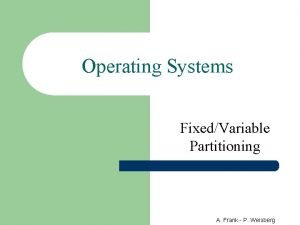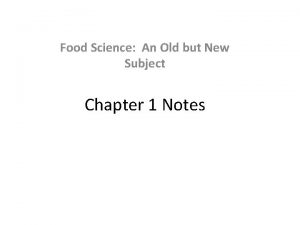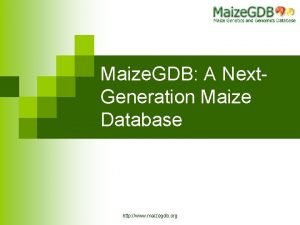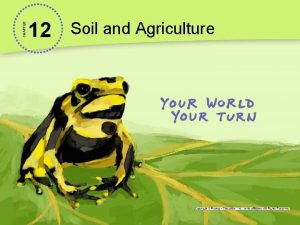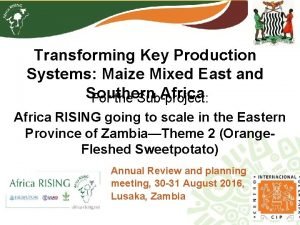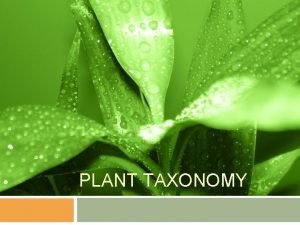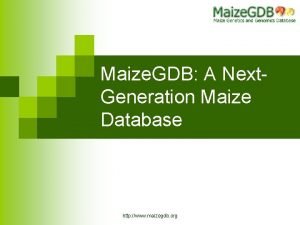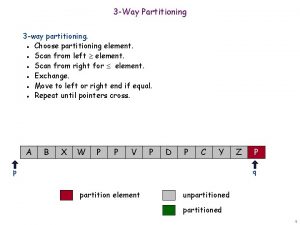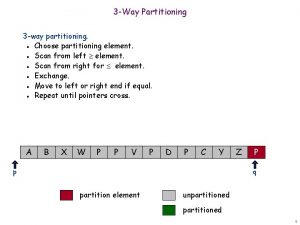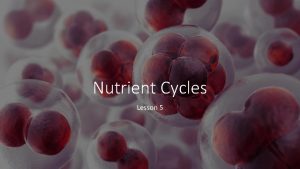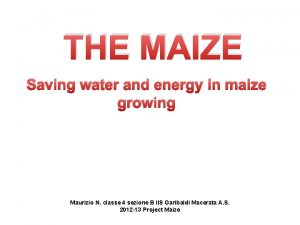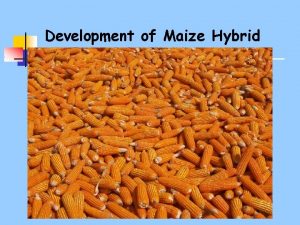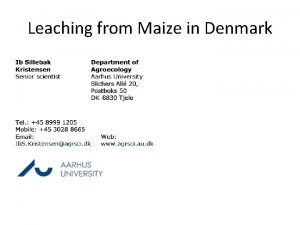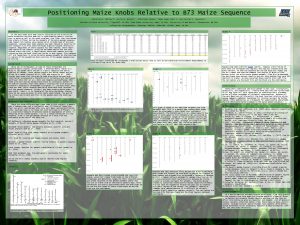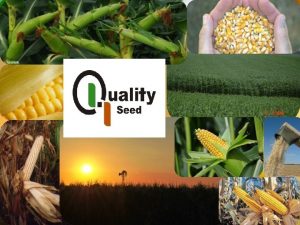Maize Nutrient Accumulation and Partitioning in Response Planting




















- Slides: 20

Maize Nutrient Accumulation and Partitioning in Response Planting Density and Nitrogen Rate Ignacio A. Ciampitti, Cropping Systems Specialist K-State Research & Extension ciampitti@ksu. edu, 785 -410 -9354 @KSUCROPS (TWITTER)

Unraveling the Physiological Puzzle of Maize Yield Formation and Plant Nutrient Uptake Processes To tal BM Plan t t n e i r t u N HI e k a pt tr u N Grain Nutrient Uptake= GY * %Nug Source: CYMMIT © IA Ciampitti, K-State Univ U t n ie Grain HI

Gap #1: Relationship between Yield and N uptake Review Paper: 100 reports (~3000 treatment means) Hybrid Era (1940 -1990 vs. 1991 -2011) Community-Level Plant-Level Ciampitti and Vyn (2012, Review Paper, Field Crops Research 133, 48 -67) © IA Ciampitti, K-State Univ

Gap #2: Dry Matter and N Partitioning at Maturity Review Paper: Hybrid Era (1940 -1990 vs. 1991 -2011) Ciampitti and Vyn (2012, Review Paper, Field Crops Research 133, 48 -67) © IA Ciampitti, K-State Univ

Gap #3: Effect on NIE and Grain N Concentration Review Paper: Hybrid Era (1940 -1990 vs. 1991 -2011) Ciampitti and Vyn (2012, Review Paper, Field Crops Research 133, 48 -67) © IA Ciampitti, K-State Univ

Gap #4: Yield and Plant N Uptake versus N rate Review Paper: Hybrid Era (1940 -1990 vs. 1991 -2011) ~2 Mg ha-1 ~1 Mg ha-1 Ciampitti and Vyn (2012, Review Paper, Field Crops Research 133, 48 -67) © IA Ciampitti, K-State Univ

FIELD RESEARCH: NUTRIENT UPTAKE in CORN Ciampitti and Vyn (2014, Field Research, Crop Management Journal 1 -7) © IA Ciampitti, K-State Univ

Plant Growth and Nutrient Uptake (Grain Yield = 210 bu/acre) “Biomass and Nitrogen” >50% of the total biomass was accumulated at flowering; while >65% of N was already present at the same stage. Ciampitti and Vyn (2014, Field Research, Crop Management Journal 1 -7) © IA Ciampitti, K-State Univ

FIELD RESEARCH Functional Physiological Framework Plant Biomass (BM) Leaf Area Index (LAI) Plant N Uptake (PNU)

Physiological N adaptations: Vegetative Period GAP #1: Is the N storage more affected than Leaf Expansion? GAP #1: At equivalent LAI, N storage capacity is mainly reduced as the N supply was diminished, regardless density and genotypes. Minor ∆Maximum LAI Ciampitti et al. (2013, Vegetative NUE, Crop Science 53: 2105 -2119) © IA Ciampitti, K-State Univ

Physiological N adaptations: Vegetative Period GAP #2: Are the leaf and stem mass and N ratios modified? V 15 Stage R 1 Stage 224 N i. Leaf to Stem Ratios at Equivalent Stage N Uptake Ratio (g g-1) Dry Mass Ratio (g g-1) 1. 0 V 15 Stage R 1 Stage 0 N 0 N 112 N Nitrogen rate Leaf: Stem Dry Mass Ratio increased (+leaf vs. stem) as 0. 50 plant density increased. 0. 44 Leaf: Stem N Uptake increased as plant density increased, but also as N is more deficient. 1. 7 PD 1 PD 2 PD 3 Plant density Ciampitti et al. (2013, Vegetative NUE, Crop Science 53: 2105 -2119) © IA Ciampitti, K-State Univ

Physiological N adaptations: Vegetative Period Stem Mass= 2/3 Total Plant Leaf Mass= 1/3 Total Plant ii. Leaf and Stem at Comparable Mass Level GAP #2: At equivalent mass, dry mass partition was not affected, but with detrimental influence over the plant %N components. Ciampitti et al. (2013, Vegetative NUE, Crop Science 53: 2105 -2119)

Physiological N adaptations: Reproductive Period GAP #3: Effect over potential kernel number and failure rate? Potential and Actual Kn C and N Allocation Plant Density GAP #3: Minimum impact over PKn, large over KFR. The KFR’s behavior is tightly related to ear C and N gains. Ciampitti et al. (2013, Reproductive NUE, Crop Science 53: 2588 -2602). © IA Ciampitti, K-State Univ

Physiological N adaptations: Reproductive Period GAP #4: Effects over Vegetative and Reproductive N uptake versus the Reproductive Shoot N remobilization rate. Slope ~0. 70 X (0 -112 N) ~0. 64 X (224 N) Intercepts ~2. 3 (0 N) ~2. 7 (112 -224 N) Slope -0. 31 X (0 N) -0. 64 X (112 N) -0. 96 X (224 N) Ciampitti et al. (2013, Reproductive NUE, Crop Science 53: 2588 -2602). © IA Ciampitti, K-State Univ

NUE: Physiological explanation Plant Biomass and Grain %N 22 NUE 26 (isolines) 28 30 32 Plant Biomass Superior NUE resulted from combinations of higher GY and lower grain %N regardless the treatment factors evaluated. © IA Ciampitti, K-State Univ

General Conclusions - From the review analysis: - i) newer hybrids presented greater tolerance to N deficiency and responsiveness as the N rate applied increased as compared to older materials - ii) superior NUE (also NIE) for newer materials can be explained by a lowering grain %N as compared to older genotypes. -Under severe stresses (crowding intensity and N deficiency intensifies): Vegetative Period = LAI, ↓ N uptake capacity, ↓ ↓ stem N reservoir, minor leaf %N Reproductive Period minor PKn, ↓ ↓ KFR, ↓ N uptake, ↑ early Shoot N Remobilization © IA Ciampitti, K-State Univ

Future Paths (plant perspective) Increase overall maize N uptake (NUE) 1 - Vegetative N uptake (A- improvements in LAI by Vegetative density changes or B- increasing leaf number or size) 2 - Reproductive N uptake Reproductive i) Changes in Sink Strength, Grain %N (Protein zein/glutelin) ii) Changes in NHI (trait stability under low N uptake levels) iii) Prolific hybrids with functional stay green trait iv) Flexible traits: to overcome the reported N uptake trade-off v) Study using maize landraces for natural NHI variability © IA Ciampitti, K-State Univ

At plant-scale: Vegetative N vs. Grain Yield Sayre, 1948 Chandler, 1960 Karlen, 1988 Ciampitti & Vyn, 2012 Ciampitti et al. , 2014 Balboa and Ciampitti, 2015 Prolific and Semi. Prolific Materials Vegetative N status was tightly related to the final per-plant CIAMPITTI & VYN, 2012 grain yield achieved at maturity. © IA Ciampitti, K-State Univ

In the Path of finding the solution for the Puzzle Crop Productivity To ta l. P BM la nt e k a pt U N t ain High N Use Efficiency Gr I H N HI n a l P © K-State Univ, Ciampitti IA Ciampitti Dr. Ignacio Antonio • Assistant Professor Crop Production/ Cropping Systems • Agronomy Department • Kansas State University

QUESTIONS THANKS! Ignacio A. Ciampitti, K-State Univ Crop Production Specialist ciampitti@ksu. edu, 785 -410 -9354 @KSUCROPS /KSUCROPS © K-State Univ, Ciampitti IA Ciampitti Dr. Ignacio Antonio • Assistant Professor Crop Production/ Cropping Systems • Agronomy Department • Kansas State University
 Venkatraman ramakrishnan medium
Venkatraman ramakrishnan medium Variable partition in os
Variable partition in os A cereal formulated from maize sorghum and cottonseed flour
A cereal formulated from maize sorghum and cottonseed flour Cost accumulation and cost assignment
Cost accumulation and cost assignment Cost accumulation and cost assignment
Cost accumulation and cost assignment Cost pools
Cost pools Cost accumulation and cost assignment
Cost accumulation and cost assignment European credit transfer and accumulation system
European credit transfer and accumulation system Maize germ uses
Maize germ uses Maize gdb
Maize gdb Possible transgenic maize in oaxaca mexico
Possible transgenic maize in oaxaca mexico Maize gdb
Maize gdb Maize
Maize Maize
Maize Maize production technology
Maize production technology Order of classification
Order of classification Maize premill
Maize premill Mayflower compact image
Mayflower compact image Maize
Maize Natural response and forced response
Natural response and forced response What is natural response
What is natural response

